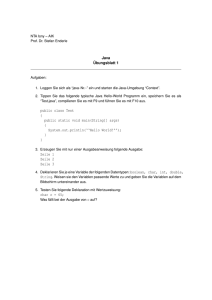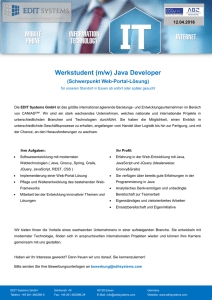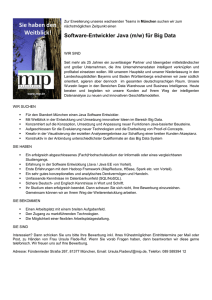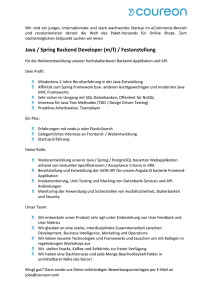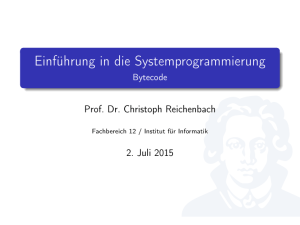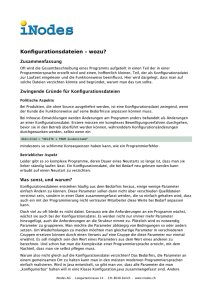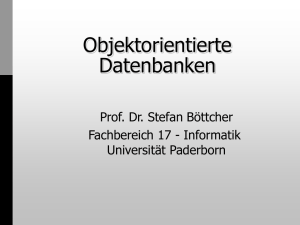Praktikum Compilerbau Sitzung 9 – Java Bytecode - IPD Snelting
Werbung
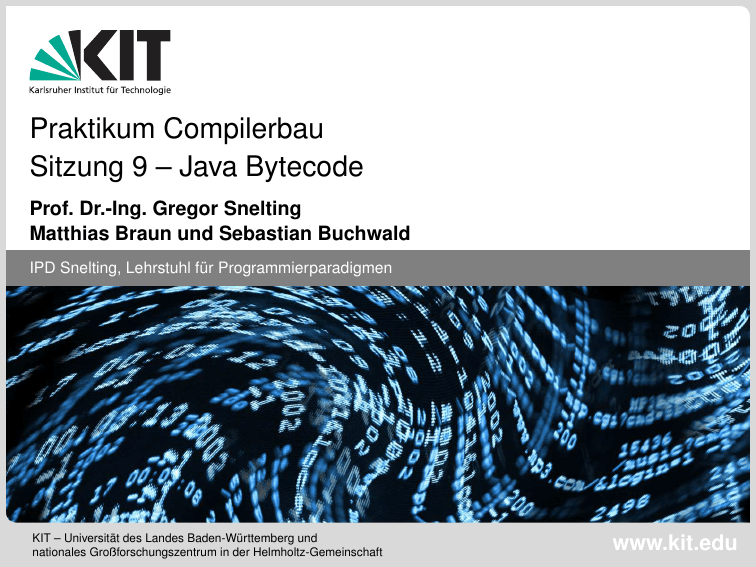
Praktikum Compilerbau
Sitzung 9 – Java Bytecode
Prof. Dr.-Ing. Gregor Snelting
Matthias Braun und Sebastian Buchwald
IPD Snelting, Lehrstuhl für Programmierparadigmen
KIT – Universität des Landes Baden-Württemberg und
nationales Großforschungszentrum in der Helmholtz-Gemeinschaft
www.kit.edu
1. Letzte Woche
2. Java Bytecode
3. Jasmin Bytecode Assembler
4. Sonstiges
2
23. Juni 2010
Matthias Braun – Sitzung 9 – Java Bytecode
IPD Snelting
Letzte Woche
Was waren die Probleme?
Hat soweit alles geklappt?
3
23. Juni 2010
Matthias Braun – Sitzung 9 – Java Bytecode
IPD Snelting
1. Letzte Woche
2. Java Bytecode
3. Jasmin Bytecode Assembler
4. Sonstiges
4
23. Juni 2010
Matthias Braun – Sitzung 9 – Java Bytecode
IPD Snelting
Java Technologie
Java Virtual Machine
Compiler
MyProgram.java
MyProgram.class
Java Virtual Machine
Portable Zwischensprache: Bytecode
Als virtuelle Maschine spezifiziert
Umfangreiche Bibliothek
Laufzeitsystem
The Java Virtual Machine Specification
http://java.sun.com/docs/books/jvms/
5
23. Juni 2010
Matthias Braun – Sitzung 9 – Java Bytecode
IPD Snelting
Virtuelle Maschine - Laufzeitsystem
Heap: Speicher für Objektinstanzen. Getypt, automatische
Speicherbereinigung (Garbage Collection), gemeinsamer
Speicher für alle Threads.
Method Area: Code für Methoden, nur lesbar.
Runtime Constant Pool: Konstante Daten (Literale,
Typinformationen, . . . )
Threads: Je Thread:
Program Counter
JVM Stack: Activation Records (Stackframes)
Native Method Stack: Für Laufzeitsystem (meist in C/C++
geschrieben)
6
23. Juni 2010
Matthias Braun – Sitzung 9 – Java Bytecode
IPD Snelting
Activation Records (Stackframe)
Rücksprungadresse
dynamischer Vorgänger
lokale Variablen:
Methodenparameter (Impliziter this Parameter an Position 0) p0 ,
p1 , . . .
Lokale Variablen v0 , v1 , . . .
p0 p1
...
v0 v1
...
Operandenstack
7
23. Juni 2010
Matthias Braun – Sitzung 9 – Java Bytecode
IPD Snelting
Bytecode, Operandenstack
Stackbasierter Bytecode: Operanden und Rückgabewerte liegen
auf Operandenstack.
Kürzere Befehlscodierung da Operanden und Ziele nicht explizit.
Maximale Stackgröße pro Methode im .class-File angegeben.
Beispiel:
top
0
8
23. Juni 2010
5
7
isub (7 − 5 = 2)
..
.
Matthias Braun – Sitzung 9 – Java Bytecode
top
0
2
..
.
IPD Snelting
Instruktionen
Typen bekannt aus Java
Instruktionen explizit typisiert: iadd (int), fadd (float)
Instruktionsklassen:
Lesen/Schreiben von lokalen Variablen (?load, ?store <x>, . . . )
Lesen/Schreiben von Feldern (getfield, putfield, . . . )
Sprungbefehle (ifeq, ifnull, tableswitch, . . . )
Methodenaufrufe (invokevirtual, invokestatic, . . . )
Objekterzeugung (new, newarray, ..)
Arithmetische Berechnungen (?mul, ?add, . . . )
9
23. Juni 2010
Matthias Braun – Sitzung 9 – Java Bytecode
IPD Snelting
Beispiel: Ausdruck berechnen
void calc(int x, int y) {
int z = 6;
x = x + y * z;
}
Lokale Variablen:
[0]
[1]
[2]
[3]
this
0x?
x
7
y
5
z
?
Stack:
Befehl:
10
23. Juni 2010
[4]
...
...
// Lade Konstante 1
iconst_1
// Schreibe in z
istore_3
// Lade y
iload_2
// Lade z
iload_3
// y ∗ z
imul
// Lade x
iload_1
// x + (y ∗ z)
iadd
// Speichere x
istore_1
Matthias Braun – Sitzung 9 – Java Bytecode
IPD Snelting
Beispiel: Ausdruck berechnen
void calc(int x, int y) {
int z = 6;
x = x + y * z;
}
Lokale Variablen:
[0]
[1]
[2]
[3]
this
0x?
x
7
y
5
z
?
Stack: ⊥
Befehl:
10
23. Juni 2010
?
?
[4]
...
...
// Lade Konstante 1
iconst_1
// Schreibe in z
istore_3
// Lade y
iload_2
// Lade z
iload_3
// y ∗ z
imul
// Lade x
iload_1
// x + (y ∗ z)
iadd
// Speichere x
istore_1
Matthias Braun – Sitzung 9 – Java Bytecode
IPD Snelting
Beispiel: Ausdruck berechnen
void calc(int x, int y) {
int z = 6;
x = x + y * z;
}
Lokale Variablen:
[0]
[1]
[2]
[3]
this
0x?
x
7
y
5
z
?
Stack: 1 ⊥ ?
Befehl: iconst_1
10
23. Juni 2010
[4]
...
...
// Lade Konstante 1
iconst_1
// Schreibe in z
istore_3
// Lade y
iload_2
// Lade z
iload_3
// y ∗ z
imul
// Lade x
iload_1
// x + (y ∗ z)
iadd
// Speichere x
istore_1
Matthias Braun – Sitzung 9 – Java Bytecode
IPD Snelting
Beispiel: Ausdruck berechnen
void calc(int x, int y) {
int z = 6;
x = x + y * z;
}
Lokale Variablen:
[0]
[1]
[2]
[3]
this
0x?
x
7
y
5
z
1
Stack: ⊥ ? ?
Befehl: istore_3
10
23. Juni 2010
[4]
...
...
// Lade Konstante 1
iconst_1
// Schreibe in z
istore_3
// Lade y
iload_2
// Lade z
iload_3
// y ∗ z
imul
// Lade x
iload_1
// x + (y ∗ z)
iadd
// Speichere x
istore_1
Matthias Braun – Sitzung 9 – Java Bytecode
IPD Snelting
Beispiel: Ausdruck berechnen
void calc(int x, int y) {
int z = 6;
x = x + y * z;
}
Lokale Variablen:
[0]
[1]
[2]
[3]
this
0x?
x
7
y
5
z
1
Stack: 5 ⊥ ?
Befehl: iload_2
10
23. Juni 2010
[4]
...
...
// Lade Konstante 1
iconst_1
// Schreibe in z
istore_3
// Lade y
iload_2
// Lade z
iload_3
// y ∗ z
imul
// Lade x
iload_1
// x + (y ∗ z)
iadd
// Speichere x
istore_1
Matthias Braun – Sitzung 9 – Java Bytecode
IPD Snelting
Beispiel: Ausdruck berechnen
void calc(int x, int y) {
int z = 6;
x = x + y * z;
}
Lokale Variablen:
[0]
[1]
[2]
[3]
this
0x?
x
7
y
5
z
1
Stack: 6 5 ⊥
Befehl: iload_3
10
23. Juni 2010
[4]
...
...
// Lade Konstante 1
iconst_1
// Schreibe in z
istore_3
// Lade y
iload_2
// Lade z
iload_3
// y ∗ z
imul
// Lade x
iload_1
// x + (y ∗ z)
iadd
// Speichere x
istore_1
Matthias Braun – Sitzung 9 – Java Bytecode
IPD Snelting
Beispiel: Ausdruck berechnen
void calc(int x, int y) {
int z = 6;
x = x + y * z;
}
Lokale Variablen:
[0]
[1]
[2]
[3]
this
0x?
x
7
y
5
z
1
Stack: 30 ⊥
Befehl: imul
10
23. Juni 2010
?
[4]
...
...
// Lade Konstante 1
iconst_1
// Schreibe in z
istore_3
// Lade y
iload_2
// Lade z
iload_3
// y ∗ z
imul
// Lade x
iload_1
// x + (y ∗ z)
iadd
// Speichere x
istore_1
Matthias Braun – Sitzung 9 – Java Bytecode
IPD Snelting
Beispiel: Ausdruck berechnen
void calc(int x, int y) {
int z = 6;
x = x + y * z;
}
Lokale Variablen:
[0]
[1]
[2]
[3]
this
0x?
x
7
y
5
z
1
Stack: 7 30 ⊥
Befehl: iload_1
10
23. Juni 2010
[4]
...
...
// Lade Konstante 1
iconst_1
// Schreibe in z
istore_3
// Lade y
iload_2
// Lade z
iload_3
// y ∗ z
imul
// Lade x
iload_1
// x + (y ∗ z)
iadd
// Speichere x
istore_1
Matthias Braun – Sitzung 9 – Java Bytecode
IPD Snelting
Beispiel: Ausdruck berechnen
void calc(int x, int y) {
int z = 6;
x = x + y * z;
}
Lokale Variablen:
[0]
[1]
[2]
[3]
this
0x?
x
7
y
5
z
1
Stack: 37 ⊥
Befehl: iadd
10
23. Juni 2010
?
[4]
...
...
// Lade Konstante 1
iconst_1
// Schreibe in z
istore_3
// Lade y
iload_2
// Lade z
iload_3
// y ∗ z
imul
// Lade x
iload_1
// x + (y ∗ z)
iadd
// Speichere x
istore_1
Matthias Braun – Sitzung 9 – Java Bytecode
IPD Snelting
Beispiel: Ausdruck berechnen
void calc(int x, int y) {
int z = 6;
x = x + y * z;
}
Lokale Variablen:
[0]
[1]
[2]
[3]
this
0x?
x
37
y
5
z
1
Stack: ⊥ ? ?
Befehl: istore_1
10
23. Juni 2010
[4]
...
...
// Lade Konstante 1
iconst_1
// Schreibe in z
istore_3
// Lade y
iload_2
// Lade z
iload_3
// y ∗ z
imul
// Lade x
iload_1
// x + (y ∗ z)
iadd
// Speichere x
istore_1
Matthias Braun – Sitzung 9 – Java Bytecode
IPD Snelting
Beispiel: Fibonnaci-Berechnung
iconst_1 // Konstante 1
istore_2 // in last0 (Var 2) schreiben
iconst_1 // Konstante 1
istore_3 // in last1 (Var 3) schreiben
iinc 1, −1 // steps (Var 1) dekrementieren
iload_1 // steps (Var 1) laden
ifle 24 // Falls <=0, springe
iload_2 // last0 (Var 2) laden
iload_3 // last1 (Var 3) laden
iadd // addiere (last0+last1)
istore 4 // in t (Var 4) schreiben
iload_2 // last0 (Var 2) laden
istore_3 // in last1 (Var 3) schreiben
iload 4 // t (Var 4 laden)
istore_2 // in last0 (Var 2) schreiben
goto 4 // springe zum Schleifenbeginn
iload_2 // last0 (Var 2) laden
Sitzung 9 – Java Bytecode
IPD Snelting
ireturn // Verlassen mit Wert
public int fib(int steps) {
int last0 = 1;
int last1 = 1;
while (--steps > 0) {
int t = last0 + last1;
last1 = last0;
last0 = t;
}
return last0;
}
11
23. Juni 2010
Matthias Braun –
Methodenaufrufe
1. Bezugsobjekt auf den Stack (falls nicht static)
2. Parameter auf den Stack
3. invokevirtual / invokestatic ausführen:
Folgendes passiert vor / nach dem Aufruf automatisch:
3.1 Array für Parameter und lokale Variablen anlegen (Größe ist
angegeben)
3.2 Returnadresse (Program Counter+1) und alten Framepointer
sichern
3.3 Neuen Framepointer setzen
3.4 this Pointer und Parameter vom Stack ins Parameter Array
kopieren
3.5 Zu Methodenanfang springen und Code ausführen
3.6 Returnwert auf den Stack
3.7 Alten Framepointer setzen und zur Returnadresse springen
4. Returnwert vom Stack holen und weiterverarbeiten
12
23. Juni 2010
Matthias Braun – Sitzung 9 – Java Bytecode
IPD Snelting
Beispiel: Methodenaufruf
int bar() {
return foo(42);
}
int foo(int i) {
return i;
}
Konstantenpool
#2
Method
#3
class
#11 Asciz
#12 Asciz
#16 NameAndType
#17 Asciz
#3.#16
#17
foo
(I)I
#11:#12
Test
int bar();
aload_0
bipush 42
invokevirtual #2
ireturn
int foo(int);
iload_1
ireturn
13
23. Juni 2010
Matthias Braun – Sitzung 9 – Java Bytecode
IPD Snelting
Deskriptoren
Namen von Klassen, Feldern und Methoden müssen einem
festgelegtem Schema entsprechen. (siehe JVMS 4.3)
Klassennamen: java.lang.Object → Ljava/lang/Object;
Typen: int → I, void → V, boolean → Z
Methoden: void foo(int, Object) →
foo(ILjava/lang/Object;)V
Deskriptor: ( Parametertypen ) Rückgabetyp
Identifiziert über “Name × Deskriptor”
Felder: boolean b → b:Z
Identifiziert nur über “Name”
Konstruktoren: Name ist <init>, Static Initializer <clinit>
14
23. Juni 2010
Matthias Braun – Sitzung 9 – Java Bytecode
IPD Snelting
Objekt erzeugen & initialisieren
1. Objekt anlegen → Speicher reservieren
2. Objekt initialisieren → Konstruktor aufrufen
Hinweis: Jede Klasse braucht einen Konstruktor (Defaultkonstruktor)!
class Test {
Test foo() {
return new Test();
}
}
#1
#2
#3
15
java/lang/Object.<init>()V
Test
Test.<init>()V
23. Juni 2010
Test();
aload_0
invokespecial #1;
return
Test foo();
new #2;
dup
invokespecial #3;
areturn
Matthias Braun – Sitzung 9 – Java Bytecode
IPD Snelting
Beispiel: Array anlegen und darauf
zugreifen
public void arr() {
int[] array = new int[10];
array[7] = 42;
}
16
23. Juni 2010
bipush 10 // Konstante 10
newarray int // array anlegen vom Typ int
astore_1 // in variable array (var 1) speichern
aload_1 // variable array (var 1) laden
bipush 7 // Konstante 7
bipush 42 // Konstante 42
iastore // Wert (42) auf array index (7)
// von array("array") schreiben
return // Aus Funktion zurueckkehren
Matthias Braun – Sitzung 9 – Java Bytecode
IPD Snelting
Beispiel: Auf Feld zugreifen
class field {
public field field;
public void setNull() {
field = null;
}
}
17
23. Juni 2010
aload_0 // Parameter0 (this) auf Stack
aconst_null // null−Referenz auf den Stack
putfield field:Lfield; // Schreibe Wert (null)
// auf Feld field:Lfield; von Objekt(this)
return // Aus Funktion zurueckkehren
Matthias Braun – Sitzung 9 – Java Bytecode
IPD Snelting
1. Letzte Woche
2. Java Bytecode
3. Jasmin Bytecode Assembler
4. Sonstiges
18
23. Juni 2010
Matthias Braun – Sitzung 9 – Java Bytecode
IPD Snelting
Jasmin Assembler
Bytecode Assembler:
Assemblersprache für Java Bytecode
Leichter lesbar → debuggen
Sprungmarken statt Bytecodepositionen
Automatischer Aufbau des Konstantenpools
http://jasmin.sourceforge.net/
Aufruf: java -jar jasmin.jar <Datei>
19
23. Juni 2010
Matthias Braun – Sitzung 9 – Java Bytecode
IPD Snelting
Jasmin Klasse
Header:
.class <Modifier> <ClassName>
.super <SuperClass>
Methode:
.method <Modifier> <Name and Deskriptor>
<Code>
.end method
Feld:
.field <Modifier> <FieldName> <Descriptor> [= <Value>]
20
23. Juni 2010
Matthias Braun – Sitzung 9 – Java Bytecode
IPD Snelting
Beispiel: Jasmin Code
.class Test
.super java/lang/Object
.method public <init>()V
aload_0
invokenonvirtual java/lang/Object/<init>()V
return
.end method
.method foo()LTest;
.limit locals 1
.limit stack 2
new Test
dup
invokespecial Test/<init>()V
areturn
.end method
21
23. Juni 2010
Matthias Braun – Sitzung 9 – Java Bytecode
IPD Snelting
Steuerfluss mit Sprungmarken
void foo(int z) {
int i = 0;
while (i < z) {
i = i + 1;
}
}
22
23. Juni 2010
.method foo(I)V
.limit locals 2
.limit stack 3
iconst_0
istore_2
l1:
iload_2
iload_1
if_icmpge l2
iload_2
iconst_1
iadd
istore_2
goto l1
l2:
return
.end method
Matthias Braun – Sitzung 9 – Java Bytecode
IPD Snelting
Zum Schluss
Anmerkungen?
Probleme?
Fragen?
23
23. Juni 2010
Matthias Braun – Sitzung 9 – Java Bytecode
IPD Snelting

